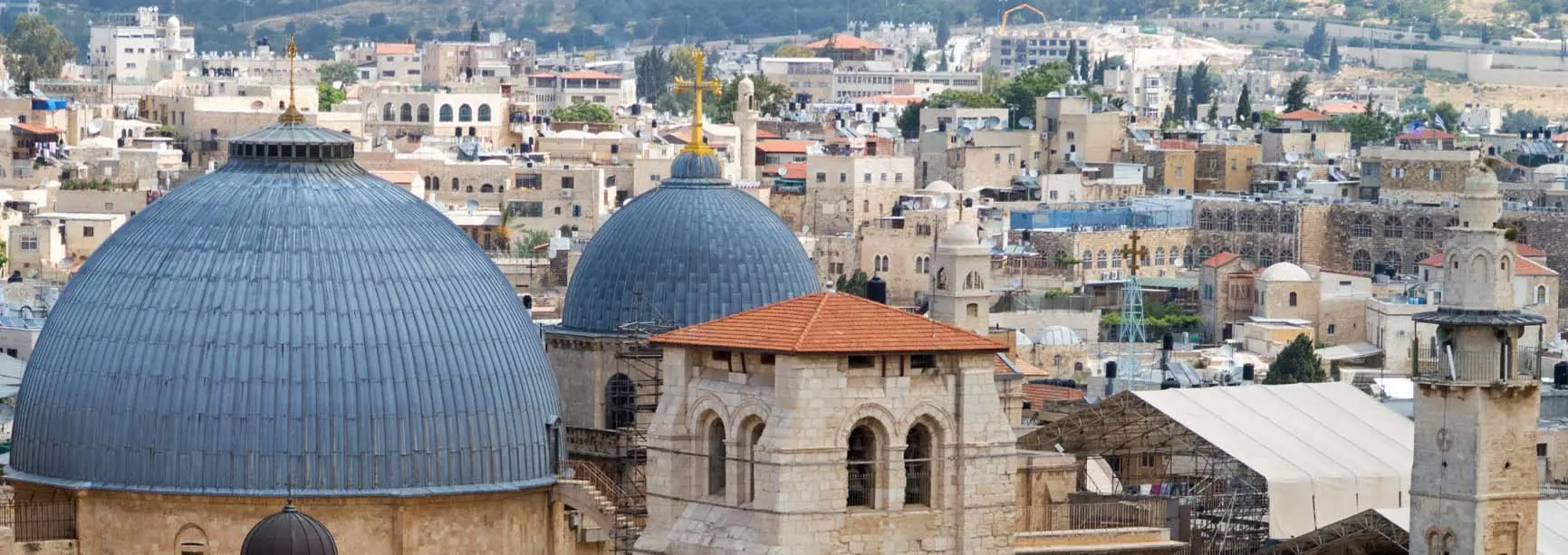

Over and above the Order’s historic connotations and its eventful progress in times gone by, the valuable and interesting aspects of the Order today lie in the role assigned to it, which it pursues within the sphere of the Catholic Church and through its administrative structure and its local organizations in various communities.
The origins of the Equestrian Order of the Holy Sepulchre of Jerusalem are generally thought to date back to the First Crusade, when the Crusade’s leader, Godfrey de Bouillon, liberated Jerusalem. As a component of his reorganization of the religious, military and public bodies of the territories newly freed from Muslim control, he founded the Order of Canons of the Holy Sepulchre. According to most accounts of the Crusades, the first King of Jerusalem, Baldwin I, assumed the leadership of this canonical order in 1103, and reserved the right for himself and his successors (as agents of the Patriarch of Jerusalem) to appoint Knights to it, should the Patriarch be absent or unable to do so.
The Order’s members included not only the Regular Canons (Fratres) but also the Secular Canons (Confratres) and the Sergentes. The latter were armed knights chosen from the crusader troops for their qualities of valor and dedication; they vowed to obey the Augustinian Rule of poverty and obedience and undertook specifically to defend the Holy Sepulchre and the Holy Places, under the command of the King of Jerusalem.
Very soon after the First Crusade the troops – including the Knights of the Order of Canons of the Holy Sepulchre – began to return to their homelands. This led to the creation of priories all over Europe, which were part of the Order as they came under the jurisdiction of the noble knights or prelates who had been invested at the Holy Sepulchre itself and who, although they were no longer in the direct service of the King of Jerusalem, continued to belong to the Order of Canons.
The Order began to decline as a cohesive military body of knights after Saladin regained Jerusalem in 1182, and completely ceased to exist in that format after the defeat of Acre in 1291. The passing of the Christian Kingdom of Jerusalem left the Order without a leader, though it continued to survive in the European priories thanks to the protection of sovereigns, princes, bishops and the Holy See. The priories kept alive the ideals of the Crusader Knights: propagation of the Faith, defense of the weak, charity towards other human beings. With the exception of events in Spain, it was only rarely that the Knights of the Holy Sepulchre ever took part again in military action to defend Christianity.
In the 14th century, the Holy See made a substantial payment to the Egyptian Sultan so that he would grant the right to protect the Christian Sanctuaries to the Franciscan Friars Minor. Throughout the whole subsequent period of the Latin Patriarchate’s suppression, the right to create new Knights was the prerogative of the representative of the highest Catholic authority in the Holy Land: the Custos.
The first documentary evidence of an investiture of Knights referred to as “of the Holy Sepulchre” dates to 1336. Since this first testament to the Order’s existence, that is, from the 14th century, the popes gradually and regularly expressed their desire to juridically annex the organization to the Holy See.
The Equestrian Order of the Holy Sepulchre of Jerusalem has always benefited from the protection of the Popes who, over the centuries, have reorganized it, augmenting and enriching its privileges. Clement VI entrusted custody of the Holy Sepulchre to the Franciscan friars in 1342, but that was still during an era when Knights alone had the right to create other members of the Order. Alexander VI declared himself the supreme moderator of the Order in 1496 and delegated to the Franciscans the power to bestow a knighthood upon nobles and gentlemen pilgrims on pilgrimage to the Holy Land (power of investiture). Confirmation of this Franciscan privilege, either verbally or by papal Bull, was renewed by Pope Leo X in 1516, by Benedict XIV in 1746.
In 1847 the Patriarchate was restored, and Pope Pius IX re-founded and modernized the Order, issuing a new Constitution which placed it under the direct protection of the Holy See and assigned its government to the Latin Patriarch. The Order’s fundamental role was also redefined: to uphold the works of the Latin Patriarchate of Jerusalem, whilst preserving the spiritual duty of propagating the Faith.
The Equestrian Order of the Holy Sepulchre opened up with the appointment of the Dames of the Holy Sepulchre thanks to Leo XIII, in 1888. Moreover, in 1907 Pius X decided that the title of Grand Master of the Order would be reserved to the Pope himself.
In 1932 Pius XI approved a new Constitution and permitted Knights and Dames to receive their investiture in their places of origin and not only in Jerusalem.
In 1949, Pius XII decreed that the Grand Master of the Order should be a Cardinal of the Holy Roman Church and assigned the position of Grand Prior to the Patriarch of Jerusalem. In 1962 Pope John XXIII and, in 1967, Pope Paul VI respectively reorganized and revitalized the Order by adding more specific regulations to the Constitution with the intention of making the Order’s activities more coordinated and more effective.
In February 1996, Pope John Paul II further enhanced the Order’s status. Today it is a Public Association of faithful with a legal canonical and public personality, constituted by the Holy See under Canon Law 312, paragraph 1:1.
Today the Order seeks to garner the commitment of its members in local churches hopeful for their personal sanctification. This is the essential and profound reason that motivated the revision of the Constitution during the “Consulta” that took place in 2013